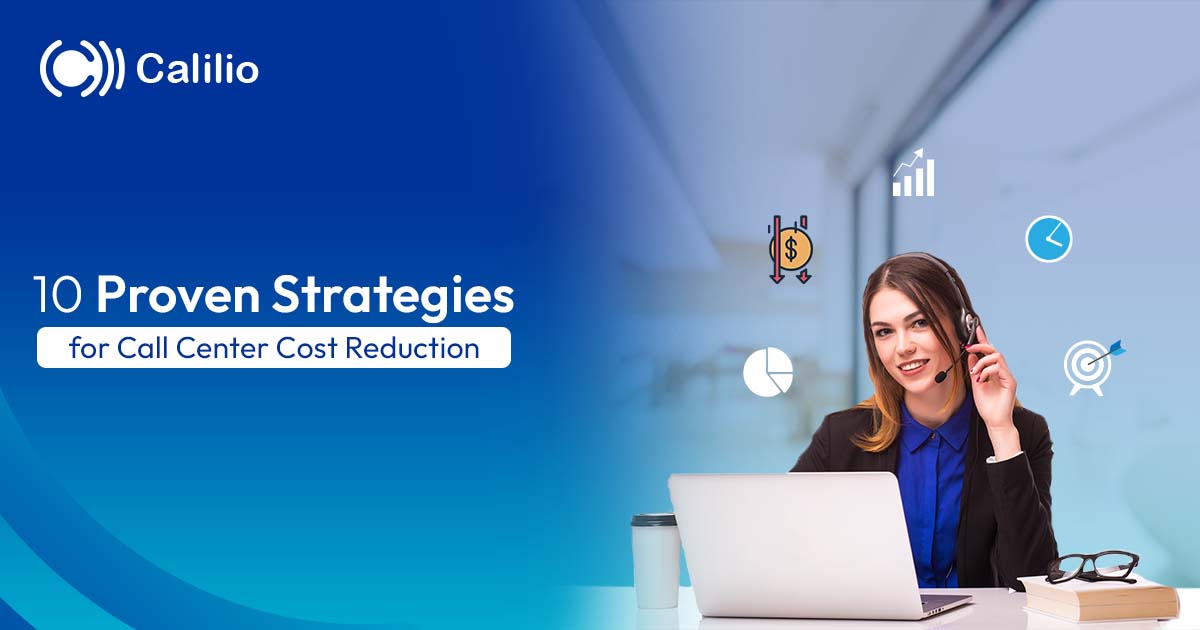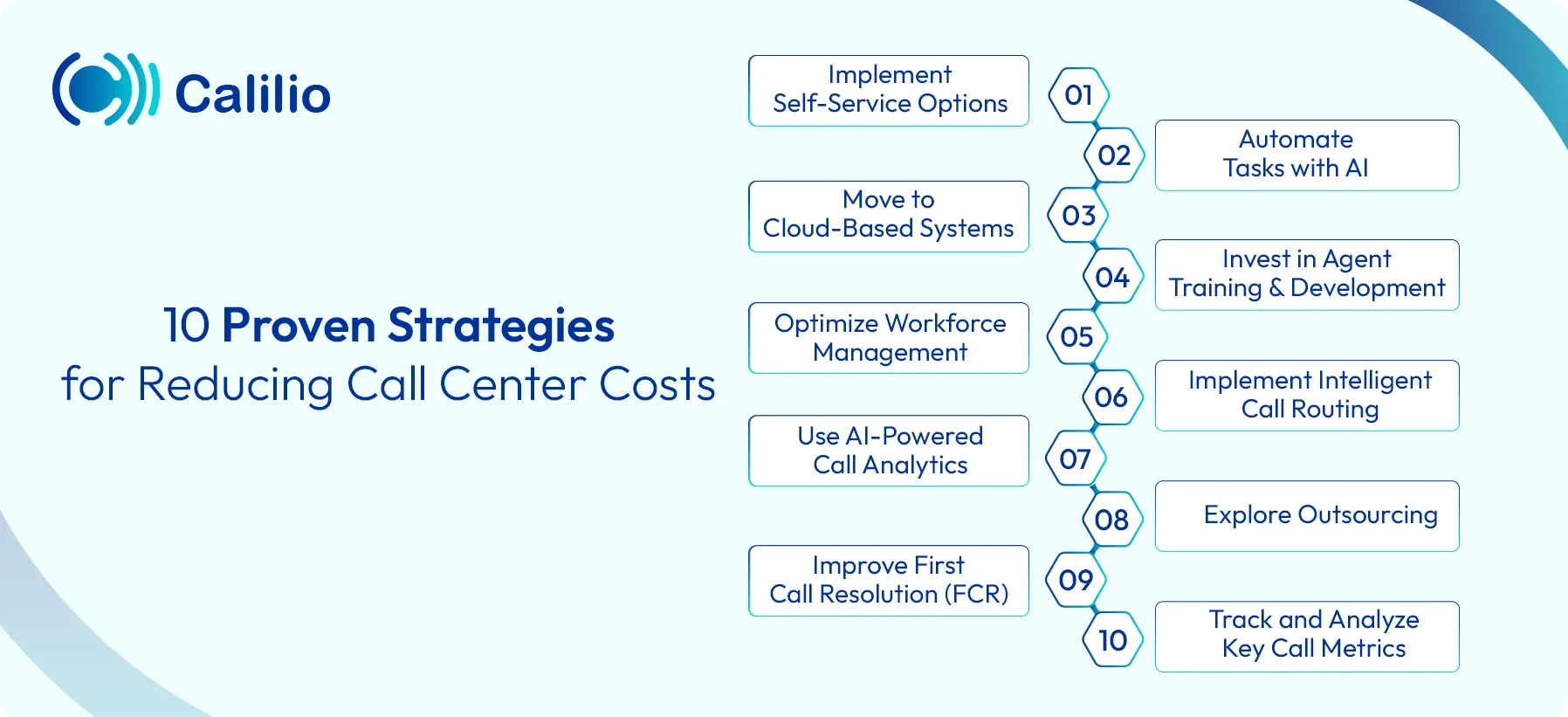How to Reduce Call Center Costs: 10 Proven Strategies for 2025

Running a call center today is more expensive than ever. From rising wages and telecom bills to expensive software and infrastructure, call center costs can quickly overwhelm your budget. Without the right approach, these expenses can limit growth and affect service quality.
Worry not! With the combination of the right technology, streamlined processes, and skilled agents, you can reduce call center expenses while also maintaining a high standard of service.
In this guide, we’ll learn the 10 proven call center cost reduction strategies, highly effective in 2025.
Keep reading!
Key Highlights:
Most call center budgets go toward staffing, telecom, technology, training, and infrastructure.
You can significantly lower costs by applying strategies like AI automation, cloud migration, smart scheduling, and data-driven decision-making.
Unexpected charges such as telecom overages, software add-ons, and early contract termination fees are some hidden expenses call centers should be aware of.
Where Do Call Centers Spend Most of Their Budget?
Call centers spend most of their budget on staffing, technology, telecom services, training, and overhead. While these areas play a vital role in delivering quality customer service, they also increase call center costs significantly.
1. Staffing Costs
In call centers, staffing cost is usually the largest expense, covering the salaries, benefits, overtime, and incentives for agents. In addition to this, high employee turnover rates can further increase costs as they require you to frequently spend more on hiring and training new employees.
2. Contact Center Software
Modern call centers rely on tools like VoIP phones, CRM software, call analytics, and recording platforms. These tools improve efficiency but also come with ongoing costs for licenses, upgrades, and integrations.
3. Telecom Services
Every call made or received carries a cost. This includes domestic and international calling rates, toll-free number charges, and data usage. Call centers need to spend a high amount on handling large call volumes across multiple countries.
4. Training and Development
Skilled agents solve problems faster, but building those skills requires consistent funding. Training costs often cover onboarding programs, product knowledge sessions, and soft skills workshops.
5. Infrastructure and Overheads
Physical call centers need space, equipment, and utilities, while remote teams may require technology allowances and secure work setups. Even in cloud-based environments, expenses like hardware, office supplies, and internet connectivity occupy a big part of the call center budget.
6. Quality Assurance and Compliance
Call centers spend on call monitoring tools, compliance audits, certifications, and security measures to maintain quality standards. While these measures help prevent costly errors or penalties, they come with an ongoing price tag.
Here’s the call center cost breakdown table, showing the expense categories and their average share of the total budget.
Expense Category | Average Share of Total Budget | Description |
Staffing Costs | 60% - 70% | Salaries, benefits, incentives, and overtime pay for agents, supervisors, and support staff |
Contact Center Software | 10% - 15% | Call center software, CRM systems, licenses, IT equipment, and maintenance |
Infrastructure & Overheads | 5% - 10% | Office space, utilities, furniture, IT equipment (computers, headsets, etc.), and internet allowances |
Telecom Services | 5% - 10% | Phone lines, VoIP services, long-distance charges, and international calling rates |
Training & Development | 2% - 5% | Onboarding programs, skill development, performance monitoring, and coaching |
Quality Assurance & Compliance | 2% - 5% | QA software, compliance audits, security measures, and industry-specific certifications |
Upgrade to a Smarter, More Affordable Call Center Solution
10 Proven Strategies for Reducing Call Center Costs
For call center cost savings, strategies such as implementing self-service tools, leveraging AI automation, migrating to the cloud, and optimizing workforce management can be highly effective. Additionally, tracking key call center metrics, intelligently routing calls, and enhancing agent training also help cut unnecessary spending.

1. Implement Self-Service Options
Self-service tools like IVR menus, chatbots, and online FAQs let customers solve simple problems without speaking to an agent. Call centers can use them to handle repetitive tasks such as checking account balances, tracking orders, or answering common questions. This lowers the number of calls agents handle, cuts wait times, and keeps your team focused on more complex issues.
Also, unlike human agents, IVR systems work 24/7. This means customers can get help anytime, which boosts satisfaction and helps reduce operational costs by lowering the need for an after-hours team.
2. Automate Tasks with AI
Call center agents often spend too much time on note-taking, tagging calls, logging outcomes, or manually entering data into CRMs. With AI, you can automate all of these: transcribing calls, detecting customer intent, and summarizing conversations instantly without much human involvement.
Automating the tasks not only speeds up post-call work but also ensures consistency. It decreases agent workload, improves call handling, and helps in call center cost savings by doing more with fewer resources.
3. Move to Cloud-Based Systems
Call centers can use cloud-based phone systems to replace costly on-premises PBX systems, eliminating hardware, maintenance contracts, and upgrade fees. These phone systems also come with telephony features like call routing, voicemail, analytics, and call recording without the overhead costs of traditional setups.
Additionally, for global teams, cloud telephony offers an affordable international calling rate, which can reduce telecom costs by up to 50%.
4. Invest in Agent Training and Development
Continuous learning helps agents solve issues faster and with fewer errors. Skilled agents can handle more calls without sacrificing quality, which reduces call transfer rates and callbacks. Over time, this results in fewer wasted resources, which contributes directly to call center cost reduction.
5. Optimize Workforce Management
Having too many agents on shift leads to wasted labor costs, while too few leads to long wait times and dropped calls. To find the right balance, use workforce management tools that help you forecast call volumes based on historical data, seasonal trends, and current demand.
With accurate forecasting, you can schedule the right number of agents for each shift and adjust staffing levels in real-time if needed. This lowers unnecessary labor costs and improves call center efficiency.
6. Implement Intelligent Call Routing
Every minute a customer spends on hold or talking to the wrong agent increases your costs. By using intelligent call routing, you can direct incoming calls to the most appropriate agent based on skills, experience, or issue type. This ensures that calls are resolved faster and more accurately, improving customer satisfaction while lowering overall handling time and cost.
7. Use AI-Powered Call Analytics
AI-powered call analytics give you deep insights into call performance, agent behavior, and customer sentiment. You can automatically analyze thousands of calls for patterns, like common complaints, long pauses, or unhappy tones. This data helps managers identify problems early, provide targeted coaching, and refine processes.
With better decisions backed by real data, your call center can operate more efficiently, avoid repeated mistakes, which eventually helps in call center cost reduction.
8. Explore Outsourcing
Outsourcing certain parts of your operations, like overflow calls, tech support, or after-hours service, can save time and money. Instead of hiring more full-time staff, you pay only for what you use. This gives you flexibility to manage call center expenses better during both slow and peak seasons while keeping quality under control.
9. Improve First Call Resolution (FCR)
Unresolved issues often lead to repeat calls, which drive up call volume, telecom charges, and agent workload. To fix this, focus on improving First Call Resolution (FCR) by training your agents effectively, offering clear knowledge resources, and routing calls to the right people.
A higher FCR helps save operational costs by reducing repeated calls and allowing agents to focus on other important tasks.
10. Track and Analyze Key Call Metrics
Tracking metrics like Average Handle Time (AHT), Call Abandonment Rate, and Customer Satisfaction Score (CSAT) gives you a clear view of your call center’s performance. By reviewing these numbers regularly, you can identify where resources are being overused or underused.
These insights help you make smarter decisions, address problems early, and reduce call center costs by managing your team and tools more efficiently.
Hidden Fees Call Centers Should Be Aware Of
Call centers should watch out for hidden fees such as extra telecom charges, software add-ons, technical support fees, and early contract penalties. If not tracked regularly, these costs can quietly increase your monthly spending without you noticing.
- Telecom Overcharges: Providers may charge extra for international calls or using toll-free numbers, especially if you haven’t subscribed to any plans.
- Software Add-Ons: Many platforms advertise low starting prices but may charge separately for essential features like call recording, analytics, or CRM integrations.
- Support and Maintenance Fees: Charges for customer support, updates, or technical assistance may not be included in your base plan.
- Contract Penalties: Cancelling a long-term contract early or switching platforms before the end of your term can result in high termination fees.
Conclusion
Running a cost-effective call center today requires making smarter, data-driven decisions. By understanding where your budget goes and applying the right call center cost reduction strategies, you can lower expenses without sacrificing service quality.
Your phone system also plays a significant role in your customer service expenses. The right solution can significantly cut telecom expenses, streamline operations, and boost agent productivity.

Get Cashbacks Up to 43% Straight To Your Wallet!
Unlimited Virtual Numbers – Local, Mobile & Toll-Free from 100+ Countries
Free Local Phone Number from US or Canada
Crystal-Clear Calls Starting at Just $0.0153/min
24/7 Human Support – Because Great Service Never Takes a Holiday


Frequently Asked Questions
Which metrics help track call center cost savings?
Metrics like cost per call and cost per resolution, along with KPIs such as AHT (Average Handle Time), FCR (First Call Resolution), agent productivity, and call volume trends, help track call center cost savings.
Can moving to cloud-based systems cut call center costs?
How much can outsourcing reduce call center costs?

Still have questions?
Can’t find the answer you’re looking for? Please chat with our friendly team.
Stay in the loop
Get the latest call insights, trends, and updates delivered straight to your inbox.
By subscribing, you agree to receive updates from Calilio.
You can unsubscribe anytime.